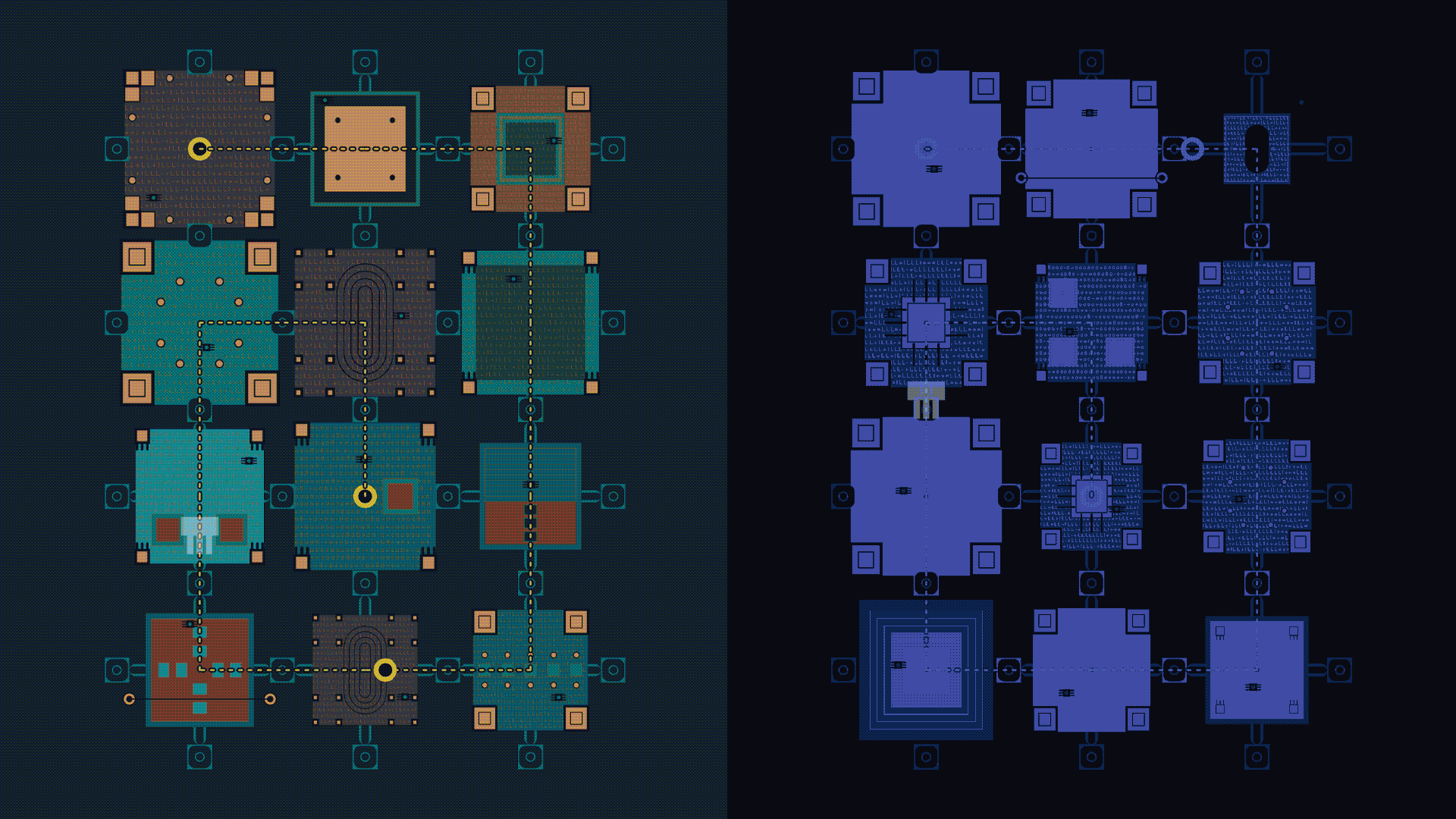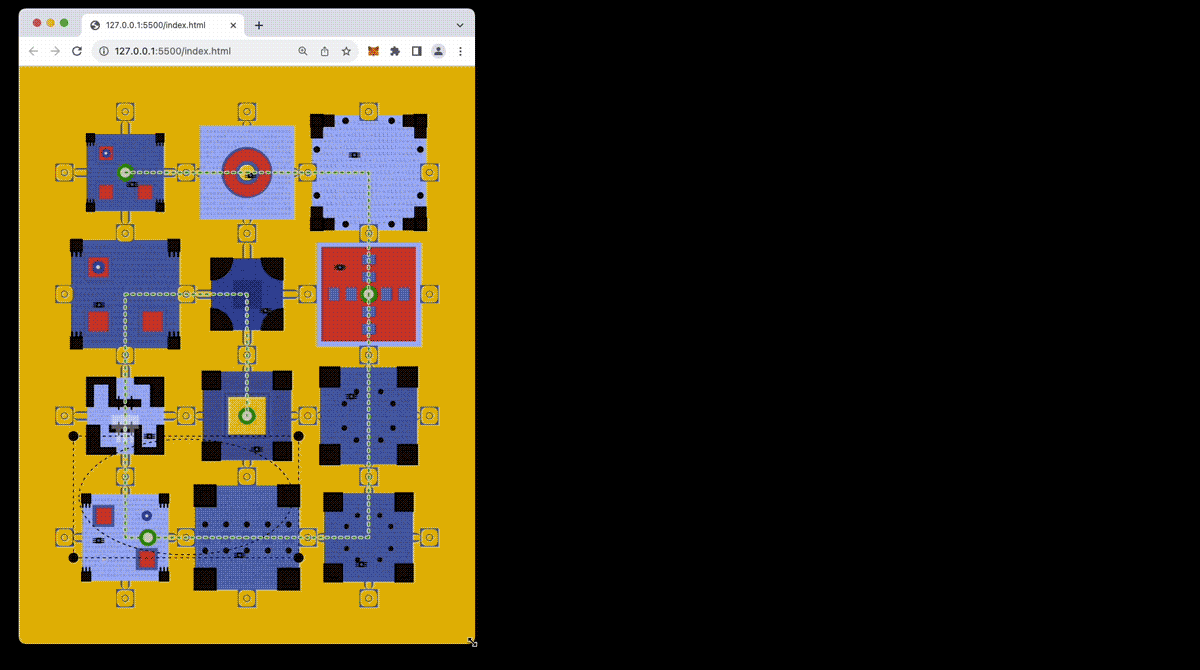Unicurse
Generative labyrinth exploring random composition of parts, meditative game-watching, and responsive screen-resize (refresh for new unicurse)
A generative algorithm and its on-screen viewing is a container of rules inside a container of rules inside a container of rules. Rules, rules, rules. As baroque or bare as you want. In this case, kind of byzantine.
Unicurse is an arrangement of 12 rooms, halfway between architectural plan and colorful circuit board. Placed together the rooms form a unicursal labyrinth connected in sequence by a thread.

The 12 rooms are built in p5.js from a kit of parts - surfaces, structure, podia, cupola - arranged randomly at mint. There are a lot of constraints shaping what goes with what. Random() is such a powerful driver of generative art, here I am trapping it with architectural regulation.
Other things join the sequential ball of thread transiting through the labyrinth; a ghost with its own pathway (its own rules), skittish bugs that scatter and occasionally explode, crypts. Color palettes with a ‘solid’ materiality are most common, others are ‘backlit’ with glowing color.
Other things join the sequential ball of thread transiting through the labyrinth; a ghost with its own pathway (its own rules), skittish bugs that scatter and occasionally explode, crypts. Color palettes with a ‘solid’ materiality are most common, others are ‘backlit’ with glowing color.
As the rooms resize to suit the window proportions (the screen, that other container of rules) they unroll to reveal an underground, then roll up again with contraction. Screen resize is a tactile way of interacting with a digital artwork whose systems recalculate and rearrange to viewing device. I like how clunky and imprecise and laggy this movement is, how extremes of proportion can nearly break the work, I like how the viewer is actively prodding and poking the algorithm via a physical viewing apparatus (mouse, touchpad, actual fingers). The medium has a friction, it almost has a sound.

The unicurse are like those little toys from the museum gift-shop, hand-held models of big ideas. Like mini zen sandpits, machines with a déjà vu of function, big things made small and simple, an easy puzzle performed absent-mindedly in the palm of your hand. Toys toys toys, rules rules rules: substrates of generative NFTs.

The labyrinth is a ubiquitous structure; a linear sequence of an ‘easy puzzle’, this then that, a game whose format and rules are implicit. Programming variations of the sequence of rooms has been a joy, incorporating the creative feedback from both WAGDIE Byzantine experts on discord and a seriously practising architect who one afternoon took a break from his work making new cities in deserts to sketch some fantasy palazzos with me.
Central to the Unicurse is the graphic attraction of the architectural plan, its symbols and language (more rules) layering up, representing a spatial yet unrealised world through a completely hypothetical viewpoint, a thought experiment slicing horizontally through mass and air.
Unicurse was published with digital art platform Highlight.
Unicurse was published with digital art platform Highlight.

I research and write about social and urban issues and their theory, policy, and industry intersections.
Alongside my research I work in urban renewal, helping government shape the strategies and outcomes of long-term large-scale precinct development to achieve economic, social and sustainability goals.
In both my research and practice I transform complex projects and problems into clear ideas and directions.
Alongside my research I work in urban renewal, helping government shape the strategies and outcomes of long-term large-scale precinct development to achieve economic, social and sustainability goals.
In both my research and practice I transform complex projects and problems into clear ideas and directions.
In both my research and practice I transform complex projects and problems into clear ideas and directions.
Contact: kirsten@kirstenbevin.com
Download CV
Publications:
James, A., Crowe, A., Tually, S., et al. (2022) Housing aspirations for precariously housed older Australians, AHURI Final Report No. 390, Australian Housing and Urban Research Institute Limited, Melbourne.
Tually, S., Coram, V., Faulkner, D., et al. (2022) Alternative housing models for precariously housed older Australians, AHURI Final Report No. 378, Australian Housing and Urban Research Institute Limited, Melbourne.
Bevin, K. (2021). Making housing, shaping old age: industry engagement in older persons housing, PhD Thesis, RMIT University.
Bevin, K. (2018). ‘Shaping the Housing Grey Zone: An Australian Retirement Villages Case Study’, Urban Policy and Research, 36(2), 215-229.
Bevin, K. (2016). ‘Diversity and disparity: Retirement housing in age-friendly cities’, in Future Housing: Global Cities and Regional Problems. Melbourne: Architecture, Media, Politics, Society, pp. 93-99.
Building buffers: Talk for the DADo Film Society (Sept ‘24)
Making housing shaping old age: Summary of PhD thesis
The story of retirement housing in Victoria: Case study within the thesis
I research and write about social and urban issues and their theory, policy, and industry intersections.
Alongside my research I work in urban renewal, helping government shape the strategies and outcomes of long-term large-scale precinct development to achieve economic, social and sustainability goals.
In both my research and practice I transform complex projects and problems into clear ideas and directions.
Contact: kirsten@kirstenbevin.com
Download CV
Publications:
James, A., Crowe, A., Tually, S., et al. (2022) Housing aspirations for precariously housed older Australians, AHURI Final Report No. 390, Australian Housing and Urban Research Institute Limited, Melbourne.
Tually, S., Coram, V., Faulkner, D., et al. (2022) Alternative housing models for precariously housed older Australians, AHURI Final Report No. 378, Australian Housing and Urban Research Institute Limited, Melbourne.
Bevin, K. (2021). Making housing, shaping old age: industry engagement in older persons housing, PhD Thesis, RMIT University.
Bevin, K. (2018). ‘Shaping the Housing Grey Zone: An Australian Retirement Villages Case Study’, Urban Policy and Research, 36(2), 215-229.
Bevin, K. (2016). ‘Diversity and disparity: Retirement housing in age-friendly cities’, in Future Housing: Global Cities and Regional Problems. Melbourne: Architecture, Media, Politics, Society, pp. 93-99.
Building buffers: Talk for the DADo Film Society (Sept ‘24)
Making housing shaping old age: Summary of PhD thesis
The story of retirement housing in Victoria: Case study within the thesis